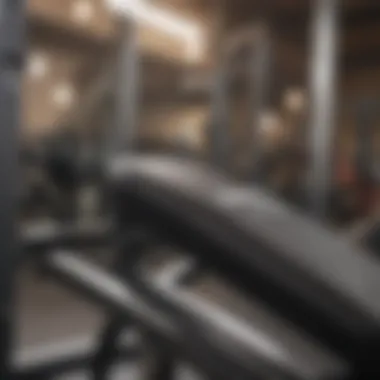Top Gym Equipment for Optimal Fitness Results


Intro
In the modern world, fitness equipment plays a crucial role in achieving and maintaining optimal health. For anyone looking to improve their fitness, choosing the right gym equipment is essential. This article delves into the various types of gym machines and tools available, analyzing their functions and benefits. By understanding what each piece of equipment offers, individuals can make informed choices and integrate the most effective tools into their workout routines.
With a wide selection of gym equipment on the market, it can be overwhelming to determine which tools are truly beneficial. This article aims to provide clarity on this subject. It is especially valuable for newcomers to fitness as well as seasoned practitioners seeking to refine their approach. Particular attention is given to how different equipment serves diverse fitness goals. Additionally, factors that should influence equipment selection for various populations will be explored.
By taking this journey through gym equipment, readers will gain insights that support a healthier lifestyle through strategic fitness choices. Understanding how each piece contributes to an overall fitness plan is imperative for sustained results.
Foreword to Gym Equipment
Understanding gym equipment is essential for anyone who wishes to improve their fitness. The right tools enable individuals to achieve a range of fitness goals and embrace a healthier lifestyle. When navigating through various fitness options, it becomes crucial to discern how specific equipment can enhance workouts. This section examines the pivotal role gym equipment plays in fitness regimes.
Understanding the Role of Equipment in Fitness
Gym equipment serves as the foundation of structured workouts. Whether one uses weights, machines, or cardio devices, each piece assists in targeting different muscle groups or promoting cardiovascular health. By utilizing the correct equipment, individuals can better their overall strength, flexibility, and endurance. The function of your chosen tool defines how effectively it will contribute to your objectives.
Moreover, different types of equipment have distinct benefits. For instance, free weights offer versatility and allow for the engagement of stabilizing muscles, while machines provide more structured movements, which can be beneficial for beginners. Moreover, the choice of equipment can impact motivation and enjoyment during workouts, leading to a higher likelihood of consistency.
Equipment Selection: Factors to Consider
Selecting the appropriate equipment requires consideration of multiple factors. Here are the key elements that influence this decision-making process:
Fitness Goals
The first factor is understanding fitness goals. Defining what one hopes to achieve, such as weight loss, muscle gain, or overall fitness improvement, will guide equipment selection. For example, if the goal is to build muscle strength, investing in free weights or weight machines would be beneficial. Choosing tools aligned with personal objectives increases motivation and ensures a more targeted workout.
Available Space
Next, available space plays a critical role in equipment selection. For those with limited room, compact equipment such as resistance bands or adjustable dumbbells are often ideal. On the other hand, individuals with larger spaces might opt for multiple machines or a full range of weights. The environment directly affects the ease of use and the types of workouts that can be performed, making it a significant factor to consider.
Budget Constraints
Lastly, budget constraints must also be acknowledged. Some equipment can be quite costly, so it’s important to establish a realistic budget. Fortunately, many options are available within different price ranges. Prioritizing essential items, such as a quality set of dumbbells or a sturdy yoga mat, can maximize value while keeping costs manageable. The balancing of quality and cost enhances overall satisfaction with any purchases made.
"Investing in the right equipment is one of the most critical steps for anyone serious about fitness."
Conclusively, understanding gym equipment and making informed selections are vital steps for achieving optimal fitness results.
Cardiovascular Equipment
Cardiovascular equipment plays a critical role in any fitness regimen. It not only enhances heart health but also provides effective calorie-burning workouts. With various options available, selecting the right machine can benefit both beginners and experienced individuals. Cardiovascular exercises improve endurance and promote overall well-being. Having access to this equipment helps individuals achieve their fitness goals efficiently, fostering a sustainable fitness routine.
Treadmills: Versatility and Functionality
Treadmills are among the most popular pieces of cardiovascular equipment. They offer a controlled environment for running or walking indoors, regardless of weather conditions. Users can adjust the pace and incline, making it suitable for all fitness levels. This adaptability allows for varied workout experiences, essential for retaining motivation. Additionally, many treadmills come with built-in programs that target weight loss or endurance, aiding in achieving specific fitness objectives.


Stationary Bicycles: A Low-Impact Alternative
Stationary bicycles provide a low-impact workout option, suitable for individuals who may have joint discomfort. They offer a solid cardiovascular workout while minimizing strain on the joints. Users can engage in cycling sessions ranging from leisurely rides to intense spin classes. The adjustable seat and handlebars ensure that each user can find a comfortable position, promoting longer and more effective exercise sessions. Many modern stationary bikes also feature performance metrics, which are useful for tracking progress.
Ellipticals: Joint-Friendly Cardiovascular Workouts
Elliptical trainers deliver a unique combination of benefits, especially for those concerned with joint health. By simulating walking or running, they allow for a fluid motion that reduces impact, which can lead to injuries. Users can target both the upper and lower body simultaneously, providing a more comprehensive workout. Furthermore, the ability to reverse the pedaling direction engages different muscle groups, making each session versatile and effective. This helps maintain a balanced fitness routine over time.
Rowing Machines: Full-Body Engagement
Rowing machines offer an effective cardio workout while also engaging multiple muscle groups. This equipment mimics the motion of rowing on water, promoting full-body engagement. Users benefit from both cardiovascular endurance and strength training simultaneously. Moreover, rowing is a low-impact exercise that places less strain on the joints compared to running or jumping. Thus, it's suitable for a wide range of fitness levels. Tracking progress through metrics such as stroke rate and distance covered helps users stay motivated and focused on their goals.
"Using cardiovascular equipment regularly not only enhances physical performance but also improves mental health, leading to a more fulfilling fitness experience."
Strength Training Equipment
Strength training equipment is curcial in achieving and maintain a balanced fitness routine. It provides the means to develop muscular strength, endurance, and overall physical performance. Engaging in strength training offers a myriad of benefits: it increases lean muscle mass, boosts metabolism, enhances bone density, and improves body mechanics. Additionally, it can help with injury prevention and promote better posture. As we explore the realm of strength training equipment, it is important to understand how various tools cater to different fitness goals and personal preferences.
Free Weights: Dumbbells and Barbells Explained
Free weights are a foundational component of strength training. They include dumbbells, barbells, and kettlebells. The significant advantage of free weights is their versatility. With a range of available weights, users can adjust resistance according to their ability and workout goals.
Dumbbells are excellent for beginners as they allow for unilateral training, addressing any muscle imbalances that may exist. They also enhance core stability since the body engages stabilizer muscles when lifting. Barbells, on the other hand, allow for heavier lifts, which is crucial for progressive overload.
When performed with proper form, exercises such as bench presses, squats, and deadlifts can effectively promote overall strength. However, it is essential to focus on technique to avoid injury. Weight selection should match personal ability, ensuring a challenge without compromising safety.
Weight Machines: Targeted Strength Building
Weight machines provide a structured approach to strength training. They typically offer guided movements, which can be beneficial for beginners unfamiliar with proper lifting techniques. Machines isolate specific muscle groups, allowing users to focus on targeted strength building.
For instance, leg press machines primarily work the quadriceps, while lat pull-down machines focus on the back muscles. This specificity can enhance muscle development and offer a controlled environment for practice.
However, reliance solely on machines may limit functional strength, as they often don’t mimic real-world movements. Therefore, integrating both free weights and machines into a regimen might be the best approach.
Kettlebells: Dynamic and Functional Training
Kettlebells have gained popularity due to their unique shape and versatility. Training with kettlebells engages muscles in a compound manner, allowing for dynamic movements that simulate everyday activities. These can include swings, snatches, and cleans that improve strength, endurance, and coordination.
The offset center of mass in kettlebells requires core engagement during movements, enhancing core strength and stability. Furthermore, the variety in exercises possible with kettlebells can alleviate workout monotony, often leading to higher engagement in fitness routines.
For those looking to improve functionality in their movements, kettlebell training is a practical choice that supports overall fitness.
Resistance Bands: Versatile and Portable
Resistance bands are a valuable tool in strength training, especially for those with limited space or budget. They come in various resistance levels and can be used in numerous exercises targeting multiple muscle groups.
Their portability makes them an ideal choice for home workouts or travel. Resistance bands can enhance exercises as diverse as squats, presses, and rows. They can also support rehabilitation efforts and increase flexibility.


Importantly, bands can offer constant tension throughout the movement, which is beneficial for muscle activation. Incorporating resistance bands into a workout routine alongside free weights can provide a well-rounded approach to fitness.
"Incorporating a variety of strength training equipment can enhance workouts and keep users engaged."
In summary, whether you lean towards free weights, machines, kettlebells, or resistance bands, the essence lies in understanding your personal fitness needs and goals. Each equipment type contributes uniquely to strength training, thus enriching the overall fitness journey.
Flexibility and Recovery Equipment
Flexibility and recovery are critical elements of any effective fitness routine. Neglecting these aspects can lead to injuries and hinder overall progress. This section will explore various tools and techniques that help improve flexibility and facilitate recovery, promoting better performance in other exercise modalities.
Foam Rollers: Muscle Recovery and Maintenance
Foam rollers have gained popularity in recent years for their ability to aid in muscle recovery and increase flexibility. These cylindrical devices are designed to provide self-myofascial release, which helps relieve muscle tightness and improve blood flow. When using a foam roller, individuals can target specific muscle groups, alleviate soreness, and enhance mobility.
The technique involves rolling the affected muscles over the foam surface, applying pressure to various points. This can be particularly beneficial after intense workouts. It helps in reducing muscle tension and may prevent injuries by promoting better flexibility. The effectiveness of foam rolling is supported by several studies that show its positive impact on muscle recovery.
Benefits of using foam rollers include:
- Increased blood circulation, which helps in nutrient transport to muscle tissues.
- Reduction of muscle soreness post-exercise.
- Enhanced range of motion, making future workouts more effective.
- Overall aid in muscle maintenance, particularly for athletes or active individuals.
Stretching Aids: Enhancing Range of Motion
Stretching aids play a vital role in promoting flexibility and improving overall physical performance. These tools support individuals in achieving a greater range of motion while ensuring they stretch safely and effectively. Various types of stretching aids are available, including resistance bands, yoga straps, and even specialized stretching machines.
Using stretching aids can significantly enhance flexibility over time. They allow users to extend their reach and maintain proper form throughout the stretching process. This can be especially useful for those who struggle to perform certain stretches independently.
Some notable advantages of utilizing stretching aids include:
- Improved posture through more effective stretching habits.
- Prevention of injuries by promoting better range of motion in joints.
- Enhanced circulation which supports muscle recovery and overall fitness.
Emerging Trends in Gym Equipment
Emerging trends in gym equipment are essential for understanding how fitness is evolving in our technologically-driven world. These trends not only reflect advancements in design and functionality, but they also align with changing user preferences and lifestyle choices. By integrating innovative technologies and focusing on functional movements, equipment manufacturers are responding to the demands of a more discerning fitness audience.
Technology Integration: Smart Equipment Features
Smart technology is increasingly being incorporated into gym equipment, offering users advanced features that enhance workout efficiency. Smart treadmills, stationary bikes, and strength equipment are equipped with technology that tracks performance data in real time. Features such as heart rate monitors, calories burned, and distance traveled provide users with feedback that can be crucial for effective training.
The benefit of these smart features is clear: they promote accountability and motivation. Users can set goals, track progress, and adjust their routines based on data insights. This measurement allows for a tailored fitness experience, making workouts more effective.
Moreover, many smart machines can connect to apps or devices, allowing users to share their progress and engage with a wider fitness community. This interaction encourages a sense of belonging, especially for those who prefer working out at home. However, it is essential for consumers to assess their comfort with technology before choosing smart equipment. It could involve a learning curve and might not suit everyone.
Functional Fitness Trends: Equipment for Everyday Movements
Functional fitness focuses on exercises that mimic daily life activities. This trend represents a significant shift in how fitness is understood and practiced. Equipment designed for functional movements, such as medicine balls, battle ropes, and cable machines, enables individuals to improve strength and mobility effectively.
One key benefit of using functional fitness equipment is the transferability of strength to real-world tasks, enhancing overall physical ability. Exercises that utilize body weight in addition to equipment provide sustainability in training. Many users appreciate this approach as it prioritizes practical outcomes over aesthetic goals.


When creating a functional fitness routine, it is important to incorporate a variety of movements. This can include pushing, pulling, squatting, or rotating. Multiple planes of motion lead to a well-rounded fitness regimen that is beneficial for longevity and everyday life. Fitness professionals should encourage clients to explore and experiment with different types of functional equipment.
"The focus on functional fitness serves not just performance, but contributes to longevity and better overall health."
Creating an Effective Home Gym
Creating an effective home gym is vital for individuals who aim to maintain or enhance their fitness regimens without the constraints of traditional gym environments. This setup empowers users by providing convenience, often resulting in improved workout consistency. Moreover, it allows for personalized training atmospheres, catering to unique preferences and needs. A well-designed home gym can also be more budget-friendly in the long term, eliminating the need for costly monthly memberships.
Essential Equipment for Limited Spaces
Selecting essential equipment for limited spaces requires strategic planning. Firstly, prioritize multifunctional tools that offer versatility for various workouts. For instance, resistance bands can provide strength training without taking up much space. Likewise, adjustable dumbbells or compact kettlebells combine numerous weights in one product, reducing clutter.
Consider implementing the following essential items:
- Compact Weight Bench: Useful for a variety of exercises and can often fold for storage.
- Resistance Bands: Take up little space yet provide a comprehensive workout.
- Foam Roller: Important for recovery, it easily fits into tight spots.
- Yoga Mat: Acts as both a surface for stretching and strength exercises.
Ensuring that the equipment is easy to use and store will promote regular workouts.
Optimizing Your Workout Environment
Optimizing your workout environment is crucial in fostering motivation and productivity. First, assess lighting options. Natural light is preferred, as it can enhance mood and energy levels. However, if this isn't possible, opt for bright lights that stimulate a lively atmosphere.
Next, ventilation should be a priority. Proper airflow prevents feelings of exhaustion and heat. Consider using fans or opening windows to create a refreshing space.
Other tips for optimizing your workout area include:
- Creating Defined Spaces: Designate specific areas for different types of exercises like cardio or strength training.
- Minimizing Distractions: Keep the area free from clutter to maintain focus.
- Adding Motivational Elements: Artwork or personal achievements can serve as inspiration during workouts.
By taking these considerations into account, individuals can transform a shared or limited space into an inviting and effective workout environment.
Closure: Making Informed Equipment Choices
In the realm of fitness, the selection of gym equipment plays an essential role in achieving optimal health. It is not merely about having access to the latest machines or trendy tools, but rather about making thoughtful choices that align with individual fitness goals and circumstances. Understanding what one needs can lead to improved results and a more satisfying workout experience.
When embarking on your fitness journey, it is critical to assess your personal fitness needs. These needs may vary based on factors such as age, current fitness levels, and specific health conditions. Selecting appropriate equipment allows individuals to engage in activities that do not cause injury while promoting physical progress. This approach encourages consistency — a vital aspect of any effective fitness regimen.
Additionally, considering your budget and available space is important. Not every piece of equipment needs to be state-of-the-art; sometimes, basic tools can yield significant results. Items like resistance bands or adjustable dumbbells can provide diverse workout options without overwhelming a smaller space or exceeding financial limits.
Informed equipment choices culminate in a better understanding of which tools will contribute most effectively to your fitness journey. It is worthwhile to seek guidance, whether from fitness professionals or reliable resources, ensuring you are well-informed before making purchases. This effort will ultimately empower you to create a tailored fitness plan that is both enjoyable and productive.
"The best equipment is often the one that fits within your lifestyle and helps you reach your personal goals."
Conclusively, the task of selecting gym equipment should not be taken lightly. Each individual's fitness aspirations are unique, and having the right tools at your disposal can greatly influence success. By thoughtfully assessing personal needs and creating an environment conducive to fitness, anyone can maximize their potential for a healthier, more active life.
Assessing Personal Fitness Needs
Assessing personal fitness needs is a foundational step when integrating gym equipment into your training. Start by reflecting on your current physical condition and fitness objectives. This may involve a personal assessment of your strengths and weaknesses, as well as a clear understanding of what you wish to achieve.
Some common elements to consider include:
- Fitness Goals: Are you focusing on weight loss, muscle building, or endurance? Different goals will require different equipment.
- Fitness Level: Beginners may need equipment that allows for gradual progression, whereas advanced fitness enthusiasts might be looking for tools that provide more intensive challenges.
- Health Considerations: Any pre-existing health conditions or injuries should influence your equipment choices. Consulting with a healthcare or fitness professional is advisable to avoid exacerbating issues.
By addressing these factors, you can create a harmonious plan that supports your objectives while promoting sustainability in your fitness journey.







